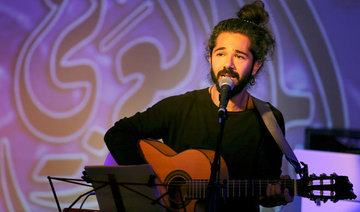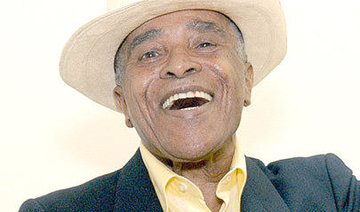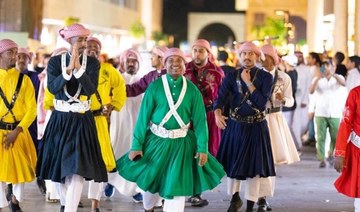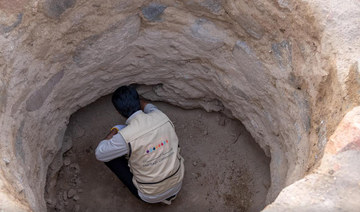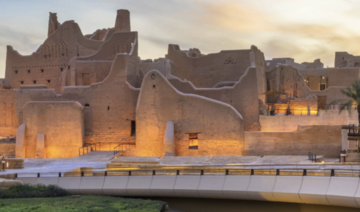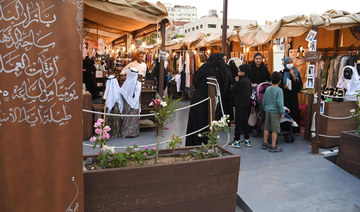NANTES, France: A hundred years ago in World War One, a group of American soldiers stormed Europe — not to the boom of guns, but the swinging rhythm of saxophones, drums and horns.
They came to fight in the mud against the Germans in a war approaching its end — but their arrival also marked the start of a sweeter, cultural conquest.
A hundred years ago on Monday, the 369th Infantry’s “Harlem Hellfighters Band” gave what is said to have been the first jazz concert on European soil — in the northwestern French city of Nantes.
“When the band had finished and the people were roaring with laughter, their faces wreathed in smiles, I was forced to say that this is just what France needed at this critical moment,” wrote one of the band members, Noble Sissle, in his memoirs.
On Monday Nantes launches a series of concerts, conferences and exhibitions to mark the centenary of that legendary gig.
Among the guests of honor at Monday night’s opening are three of the grandchildren of the orchestra’s leader, Lt. James Reese Europe — the black American bandleader known as the “king of jazz.”
After that night at Nantes’s Theatre Graslin, Europe would never sound the same again.
It “turned France upside down,” according to local press reports from the time.
“The ‘Jazz germ’ had hit them,” Sissle wrote, “and it seemed to find the vital spot.”
The 369th Infantry was one of the four African American regiments sent from the racially segregated US to fight under French command.
James Reese Europe “was the first African American officer to lead troops in a wartime attack,” said Matthieu Jouan, head of the “100 Years of Jazz” commemorations in Nantes.
The officer also put together the 40-strong band which included “some of the best of the time,” Jouan added.
When they were not fighting at the front, they played to entertain the troops and locals.
“People went crazy everywhere they toured to,” said Jouan.
The 369th Infantry received the Croix de Guerre French military decoration for bravery.
France also awarded the Legion d’Honneur to 171 members of the regiment for liberating the village of Sechault, where a monument to them now stands.
Lt. Europe composed one of his best-known tunes, “One Patrol in No Man’s Land,” while lying injured in hospital.
He returned from the war a hero, only to die months later in May 1919 at the age of 39 — stabbed in the neck by one of his bandmates.
The headlines in the American press read: “The king of jazz is dead,” said Jouan.
But the officer’s death coincided, he added, with the rise of three great musical stars: Duke Ellington, Louis Armstrong and Sidney Bechet.
The jazz age had begun.
A century ago today, jazz broke loose in Europe
A century ago today, jazz broke loose in Europe
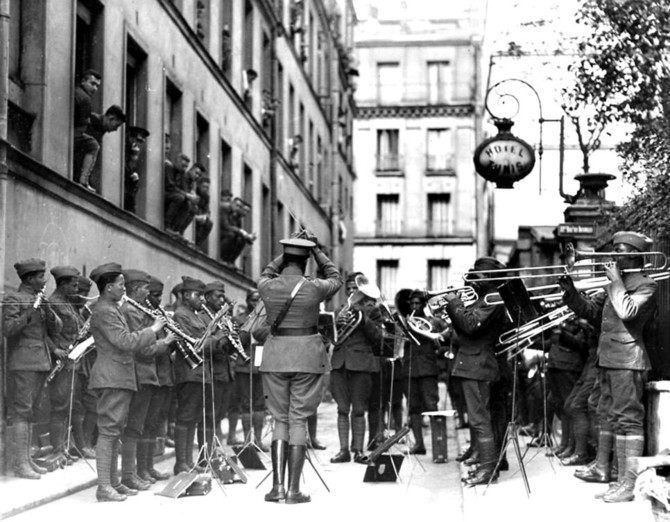
Saudi Music Commission hosts open meeting on preserving national musical heritage
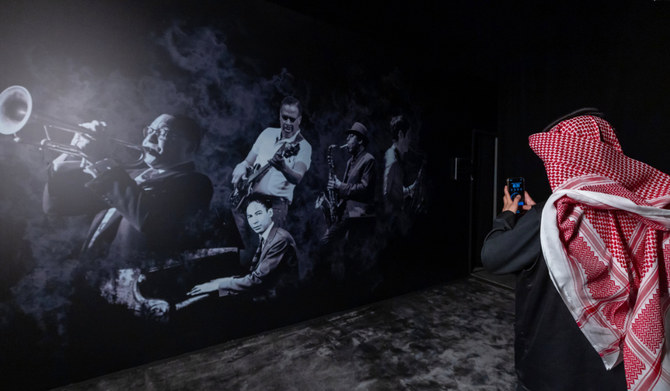
- The meeting highlighted the achievements of the Saudi Music Memory initiative, which secured rights for over 5,000 works, documented 305 musical notations, and produced two musical notation books
RIYADH: The Music Commission hosted an open meeting on the Saudi Music Memory initiative, engaging with music enthusiasts and industry professionals, the Saudi Press Agency reported on Tuesday.
The goal was to involve them in preserving the Kingdom’s musical heritage, as part of a series of open meetings designed to keep the musical community informed and encourage their participation in documenting and preserving Saudi music.
The virtual meeting outlined the initiative’s focus on documenting music and lyrics composed by Saudi artists through the mid-1980s, aiming to preserve and archive these works and the evolution of the Saudi music scene.
The meeting highlighted the achievements of the Saudi Music Memory initiative, which secured rights for over 5,000 works, documented 305 musical notations, and produced two musical notation books. The first book, titled “From the Memory of National Songs,” was released to coincide with this year’s Founding Day. The second book, “From the Memory of Ramadan Songs,” is completed and set to be published before Ramadan 2025.
The meeting featured interviews with renowned artists who experienced the early days of Saudi music, like Mohammed Abdu, Abadi Al-Johar, and Jamil Mahmoud, who shared stories about the origins of Saudi music and the role of its pioneers.
The meeting outlined the stages of the initiative, beginning with securing the rights to use classical musical and lyrical works, which has been completed. The second stage, transcribing musical works, is underway. Next, the commission plans to create documentary content and reproduce and distribute significant musical works, expected to be completed in the upcoming year. Once these stages are finished, the final step will be building an integrated platform.
The commission adhered to a scientific methodology, ensuring honesty and neutrality in all outputs of the initiative. It eliminated community and private artistic biases, aligned with the Saudi Cultural Memory Center, followed the guidelines in the documentation and digital archiving manual issued by the Ministry of Culture, and conducted a comprehensive inventory of all relevant materials and information.
The commission launched the Saudi Music Memory initiative to document the history of Saudi art, aiming to create a reliable reference, highlight its regional influence, offer academically documented research for musicians, researchers, and interested parties, and showcase high-value musical works that have not received due media attention, the SPA reported.
Macklemore shares teaser for new song in support of Gazans

DUBAI: American rapper Macklemore is set to release a new song this week in support of Palestine.
Titled “Hind’s Hall,” the track honors Hind Rajab, the 6-year-old Palestinian girl who was killed by Israeli soldiers in Gaza while waiting to be rescued.
Drawing its inspiration from the global student protests, the singer released a teaser of the track on his Instagram feed and said that all proceeds from its sale would be donated to the UN agency for Palestinian refugees.
“The people, they won’t leave / What is threatening about divesting and wanting peace? / The problem isn’t the protests, it’s what they’re protesting / It goes against what our country is funding / Block the barricade until Palestine is free,” he sings.
“What you willing to risk? / What you willing to give? / What if you were in Gaza? / What if those were your kids? You’d want the world to stand up / And the students finally did.”
The full song has yet to be released on streaming platforms.
Saudi Heritage Commission event celebrates ancient Rakah
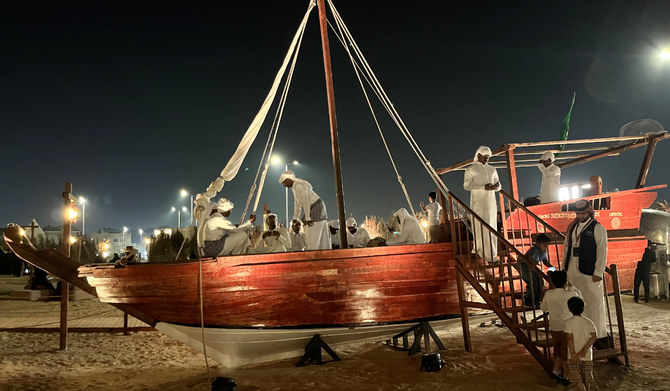
- “We want our customers to enter our space, either in our booth at the event this week or our studio location, and in just a short time be able to produce something customized to take home, she told Arab News
DAMMAM: The Heritage Commission is holding an event to celebrate ancient Rakah, with historical reenactments, guided tours, archaeological experts and handicrafts.
Once a major trading spot, some 1,500 years ago, the area takes its name from an indigenous tree species that once flourished there. The sandy environment was also once under the sea and shells can be found still glued to the rocks.
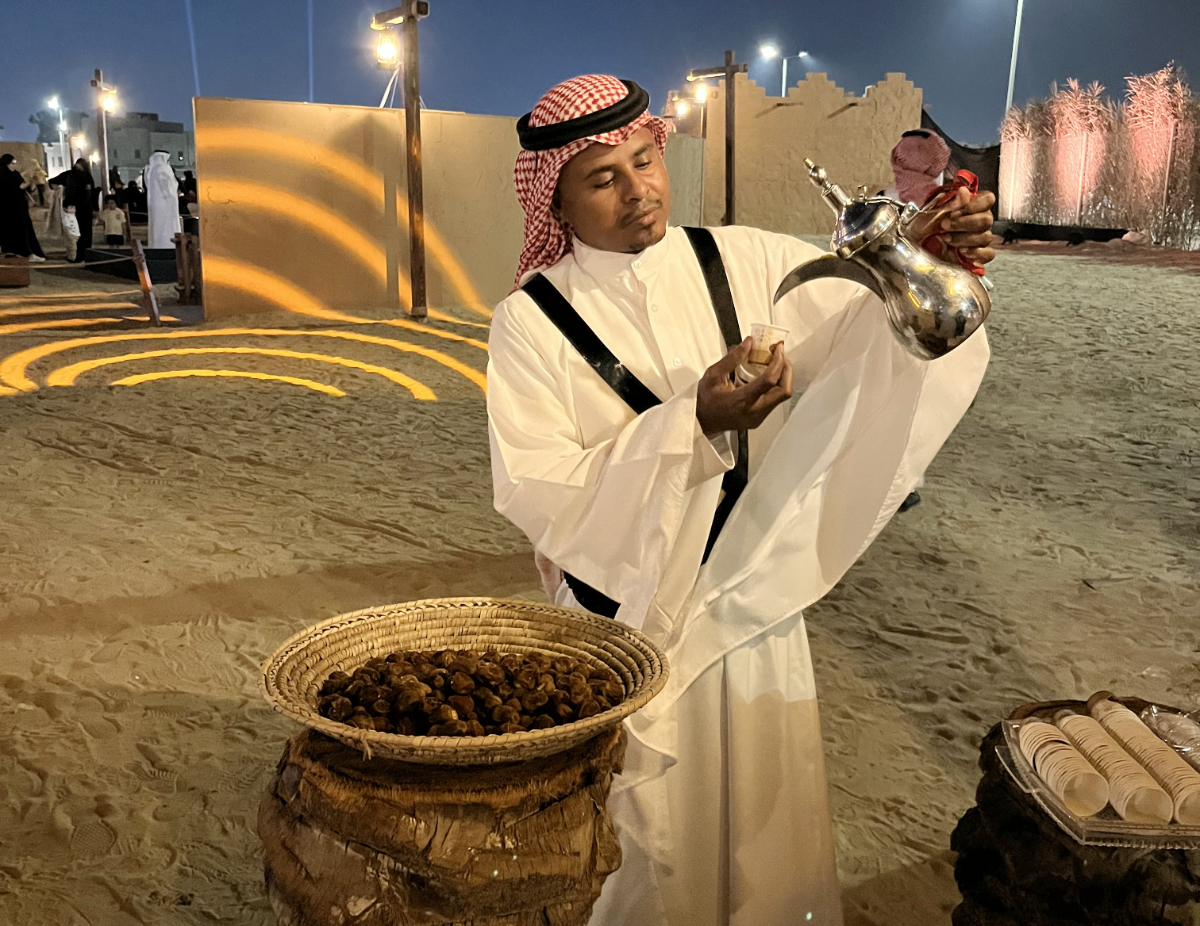
Many of the guides are female archaeology graduates from Imam Abdulrahman Bin Faisal University, formerly known as the University of Dammam.
Wala Al-Nafaiai, who co-founded Dam Studio, a local business that specializes in handmade goods made of cow and camel hide, said she was looking forward to showing off her products to visitors.
FASTFACTS
● Once a major trading spot, some 1,500 years ago, the Rakah area in Dammam takes its name from an indigenous tree species that once flourished there.
● The sandy environment was also once under the sea and shells can be found still glued to the rocks.
“We want our customers to enter our space, either in our booth at the event this week or our studio location, and in just a short time be able to produce something customized to take home, she told Arab News.

“Instead of going to a restaurant, we want you to spend the time to have an experience, produce something practical and learn skills you can utilize later.”
Al-Nafaiai said she was delighted with how many people had taken part in the workshops she provided at her booth.
It seems many (people) enjoy customizing something that they feel connected to once they make it with their own hands.
Wala Al-Nafaiai, Dam Studio co-founder
“It was so crowded … I was surprised that there were more adults than children who wanted to join in, although the craft was very simple,” she said.
“It seems many (people) enjoy customizing something that they feel connected to once they make it with their own hands. And that is our goal and the goal of the Heritage Commission who invited us to join this successful event.”

Visitors were also able to learn about the importance of dates to the community in ancient times and how local people would make and trade date syrup with visiting merchants.
Organized in cooperation with the Sharqiya Development Authority, the festival ends on Tuesday. For more information, visit heritage.moc.gov.sa or @mocheritage.
Riyadh forum highlights importance of cultural identity and Arab heritage
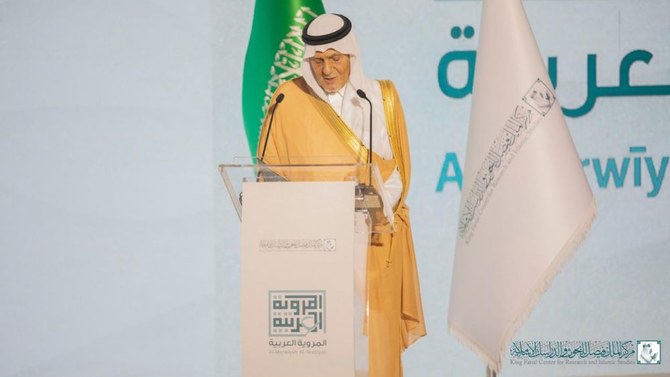
- Scholars, officials, experts explore and celebrate Arabian Peninsula
- Katakura Kunio said that both Japanese and Islamic cultures had historic roots in promoting peace
RIYADH: The Al-Marwiyah Al-Arabiyah Conference, called “Desert Culture,” concluded on Monday in Riyadh. The two-day event brought together a diverse group of scholars, officials, and experts to explore and celebrate the rich cultural heritage of the Arabian Peninsula.
Prince Turki Al-Faisal, the chairman of the King Faisal Center for Research and Islamic Studies, said that nomadism was central to Arab culture, emphasizing its roots in values over materialism. He noted that Arabs were natural storytellers, adept at turning chaos into clarity.
Katakura Kunio, president of the Motoko Katakura Foundation for Desert Culture in Japan, delivered a speech in memory of his late wife, anthropologist Motoko Katakura, which highlighted her research in Saudi Arabia.
Kunio said: “Motoko’s enduring passion for comfort inspired our foundation to establish the Comfort Prize, aimed at supporting both Japanese and international researchers and artists. This award honors individuals who dedicate their lives to enriching desert culture.
“In the current climate of positive change within Saudi Arabia, including the increased societal participation of women and the focus on tourism development, it is natural to re-evaluate the traditional value of comfort. Perhaps, in a world increasingly driven by hyper-capitalism, comfort can offer a remedy for the global population yearning for a slower pace.”
Kunio said that both Japanese and Islamic cultures had historic roots in promoting peace. He noted that Prince Shotoku of Japan endorsed “respect for peace” in his 17-Article Constitution, while the Prophet Muhammad established the Madinah Charter, which also emphasized peace and tolerance. These parallels suggested a common ground for fostering cross-cultural understanding, he added.
Abdullah Hamidaddin, assistant secretary-general for scientific affairs at the KFCRIS, described Al–Marwiyah Al-Arabiyah as a research initiative which aimed to address confusion about Arab civilization. It sought to combat attempts to undermine and marginalize Arab culture.
Hamidaddin said that the project used scientific methods to study Arab narratives and the origin of language in the Arabian Peninsula, while promoting dialogues, field studies, and critical analyses in various fields, including history, archaeology, sociology, philosophy, literature, and art.
The conference aimed to highlight the civilizational and cultural significance of the Arabian Peninsula, while seeking to strengthen the sense of Arab identity for future generations. It also promoted cultural exchange between the Arab world and neighboring regions.
A lecture titled “Gifts of God (Camels),” by Sulaiman Al-Theeb, cultural adviser at the center, was presented during the conference.
He spoke of the Arabian Peninsula’s deep connection with camels through three key concepts: rock and mural art; archaeological finds, like daily tools; and references to camels in ancient Arabic inscriptions, especially Thamudic writings.
Al-Theeb highlighted the significant status of camels in the region, which has earned them the moniker “the ship of the desert.”
Mohammed Al-Rowaily, a member of the Cultural Council at the Abdulrahman Al-Sudairy Cultural Center, said that the Arabic narrative played a crucial role in sharing ideas with others. He noted that Arabic storytelling enhanced cross-cultural understanding by conveying elements from history, oral literature, civilization, arts, and other creative works.
Hajar Al-Shammari, a linguistic researcher in Saudi history, said that the event boosted cultural engagement by fostering dialogue and cultural exchange among academics. Through the sharing of ideas it helped to establish a foundation for field studies and critical analyses focused on Arab perceptions and identity.
Al-Shammari added that Arabic storytelling played a significant role in promoting social cohesion, fulfilling the search for roots, and reinforcing values. This was especially important in the context of cultural identity and Arab heritage.
Moroccan photographer Hassan Hajjaj captures the culture of AlUla

- The acclaimed Moroccan photographer discusses his recent show in Saudi Arabia
DUBAI: Early in February this year, Moroccan contemporary artist and photographer Hassan Hajjaj was given a reminder of just how high his star has risen. Within a few days of each other, Hajjaj had shows opening in the US, Morocco, and — as part of AlUla Arts Festival — Saudi Arabia.
Hajjaj’s playful portraiture, which incorporates vivid color, funky clothing (almost all of which he designs himself), geometric patterns, and — often — vintage brands from the MENA region, has made him internationally popular, and his instantly recognizable style has established him as one of the world’s leading photographers.
His show in AlUla consisted of images that he shot in the ancient oasis town in February 2023. That visit was initially supposed to involve shoots with around 20 local people. It’s the kind of thing he’s done a few times before, including in Oman and Abu Dhabi. “It’s always a good opportunity to get to know the culture and the people,” Hajjaj tells Arab News.
But, as he says himself, he arrived in AlUla as “an outsider,” so needed a team on the ground to persuade locals to come and sit (or stand, in most cases) for him.
“It was a bit tough, in the beginning, for them to find people,” Hajjaj explains. “But because it was during a period when lots of art things were happening in AlUla, there were lots of people coming from outside AlUla as well. So we opened it up. I basically said, ‘Just come.’
“In the end lots of people turned up, not just locals — people from Riyadh, Jeddah, and people (from overseas) too. I think I shot around 100 people over a few days. So it was a great opportunity,” he continues. “To get to shoot that many people over three days — organizing something like that for myself might take a year. So, as long as I have the energy, when I get these opportunities — you know, I’m in AlUla with this eclectic bunch of people — I’d rather go and grind it, really work hard, and have that moment.”
A Hassan Hajjaj shoot isn’t your regular portrait shoot, of course. “It’s almost like a performance,” he says. “There’s music, people dress up, it’s like a day out for them, taking them out of themselves for a few hours.”
He followed the same modus operandi in AlUla. “We got an ambience going. It was fun, there was music… I shot in this beautiful old school that was one of the first girls’ schools in Saudi Arabia, from the Sixties. Upstairs was like a museum — everything was like a standstill from the Seventies and Eighties; even the blackboards had the chalk and the writing from that time,” he says.

A crucial part of Hajjaj’s practice is to ensure that his subjects are at ease and feel some connection with him (“comfortable” is a word he uses several times when talking about his shoots). While all his portraits bear his clearly defined style, it’s important to him that they should also show something unique to the people in them.
“It’s that old thing about capturing the spirit of the person in that split second, you know? I’m trying to get their personality and body language in the image,” he says. “Quite often I’m shooting in the street, outdoors, so (the subjects) can start looking at other people, thinking, ‘Are they looking at me?’ So I usually say, ‘Listen. This is a stage I’m building for you. I’m dressing you up, and we’re going to have fun.’ Then I just try and find that personality that can come out and make the image stronger. With some people, though, saying almost nothing can be better — just getting on with it. I try to kind of go invisible so it’s the camera, not the person, that’s doing the work. The best pictures come out when there’s some kind of comfortable moment between me and the person and the camera.”
It’s the way he’s worked since the beginning — a process that developed organically, as most of his early portraits were of “friends or friends of friends.”

“There’s a comfort in that because you have a relationship with them. It made it easy,” he says. “And that taught me about how important it is to build trust with people to get into that comfortable zone. But as time went on, obviously, people could see the stuff in the press or on social media, so then people started, like, asking to be shot in that manner; maybe they’ve studied the poses of certain people and stuff like that, so they come ready to do some pose they’ve seen in my pictures. That’s quite funny.”
The work that was on display over the past two months in Hajjaj’s “AlUla 1445” is a perfect example of what he tries to achieve with his shoots. The images are vibrant, playful, and soulful, and the subjects run from a local goatherder through the AlUla football team to bona fide superstars: the US singer-songwriter Alicia Keys and her husband Swizz Beatz.
Hajjaj says he has a number of favorites “for different reasons,” including the goatherder.

“He brought in two goats and it became quite abstract when you put all of them together. I was playing with that notion of the person; you could see that’s his life and even the goats look happy,” he explains. “I wanted to make sure they had that shine in the image as well. I got some great shots of him.”
The Alicia Keys and Swizz Beatz shoot has been a long time in the making. Hajjaj first met Swizz Beatz a decade ago, and they have been in touch intermittently ever since. The idea of a shoot with Keys first came up about five years ago, but logistics had always got in the way. But since they were playing a concert in AlUla at the same time as Hajjaj was there, it finally happened, on Hajjaj’s last day, with perhaps an hour left before the light faded.
I ask Hajjaj if his approach to shooting celebrities differs from his shots of “ordinary” people.

“There’s probably not that much difference,” he says. “They’re coming into my world, so, again, it’s just making sure they’re comfortable with you and you’re comfortable with them; not looking at them (as celebrities). The only thing is you have to imagine they’ve been shot thousands of times — by top photographers, too — so they’re going to have their ways. So I just have to lock in with them and find that comfortable space between the sitter and me.”
And then there’s Ghadi Al-Sharif.
“It’s a beautiful picture. She’s got this smile, with her hand over her face. For me, that one really presents the light and the energy of AlUla,” Hajjaj says. “It captures the new generation.”



